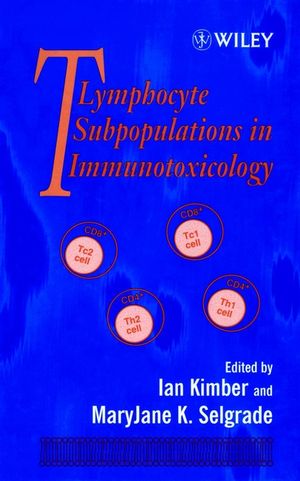T Lymphocytes Subpopulations in ImmunotoxicologyISBN: 978-0-471-97194-8
Hardcover
312 pages
August 1998
 This is a Print-on-Demand title. It will be printed specifically to fill your order. Please allow an additional 10-15 days delivery time. The book is not returnable.
|
||||||
T Lymphocyte Subpopulations in Immunotoxicology Edited by Ian Kimber ZENECA Pharmaceuticals, Central Toxicology Laboratory, Macclesfield, Cheshire, UK and Mary Jane K. Selgrade US Environmental Protection Agency, National Health and Environmental Effects Research Laboratory, NC, USA Immunotoxicology is a diverse discipline that embraces the investigation of the adverse health effects that may result from the interaction of xenobiotics with the immune system. T lymphocytes orchestrate adaptive immune responses and are of central importance in the consideration of immunotoxicity. These cells and/or the tissue responsible for their functional maturation (the thymus) have been implicated as the primary or secondary targets for chemical insult. Moreover, T lymphocytes play pivotal roles in the induction and elicitation of chemical and protein allergy and in the pathogenesis of autoimmune disease. Classically, T lymphocytes have been divided into two main populations: CD4 helper T cells and CD8 suppressor/cytotoxic T cells. It is now apparent that there exists within both populations considerable functional heterogeneity, characterized usually by variable cytokine secretion patterns. Two major subpopulations of T helper (Th) cells have been identified and designated Th1 and Th2, with similar, but less well characterized, sub-types of cytotoxic (Tc) cells having been described also. The discovery of functional subpopulations of Th (and Tc) cells has profoundly influenced our view of the immune response and, in particular, our appreciation of the way in which the immune system can tailor responses to meet challenges of different types. This has also translated into a much more detailed understanding of certain immunopathologic processes and the role of T lymphocytes in the development of allergic, autoimmune and inflammatory diseases. This book explores the role of T lymphocyte subpopulations in the development and expression of immunotoxic effects. Constituent chapters reveal that a consideration of the impact of chemicals on these diverse T cell populations and the polarization of T cell responses has already contributed greatly to our understanding of the mechanisms underlying immunotoxicity, including immune suppression and allergic and autoimmune responses.



